PowerMyLearning, a Reimagine Learning grantee-partner, leverages a digital platform to bring students, families, and teachers together to create joyful personalized learning experiences.
PowerMyLearning, a Reimagine Learning grantee-partner, leverages a digital platform to bring students, families, and teachers together to create joyful personalized learning experiences.
Vanessa Kirsch’s daughter, Mirabelle, at a Reimagine Learning convening with David Flink, who founded Eye to Eye to unlock greatness in the 1 in 5 who learn differently.
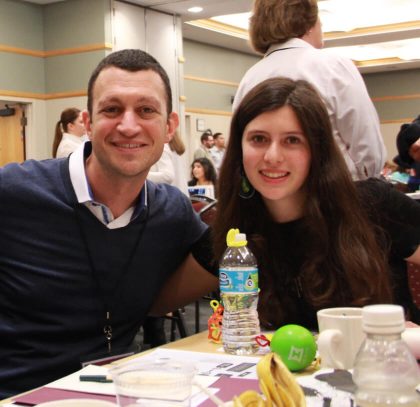
By the time her daughter was in elementary school, Vanessa Kirsch had launched and led three social impact organizations. From Public Allies, which engages and activates the leadership capacities of young people, to New Profit, which identifies and backs visionary social entrepreneurs, Kirsch had demonstrated a penchant for seeing and cultivating talent. She brought to this work a deep commitment to seeing the potential and possibility in everyone. Perhaps unsurprisingly, this grew out of her own experience as someone who was not always seen as having potential. Kirsch was diagnosed with dyslexia as a second grade student in a Boston area public school, and after struggling through school, she had to learn to become her own advocate. Decades later, when Kirsch’s own daughter was diagnosed with dyslexia and entered a public elementary school known for being supportive of students with learning differences, Kirsch saw her transform from a vibrant and motivated child to one who was frustrated and discouraged. Despite decades of efforts in the field to advance educational opportunity and equity in the U.S., Kirsch was seeing through her daughter’s experience that we still hadn’t achieved the promise of the education reform movement and not enough progress had been made for certain subgroups of students.
New Profit Founder and CEO Vanessa Kirsch stands with Grammy winner and activist John Legend at the public launch of Reimagine Learning at Mercedes-Benz Fashion Week.
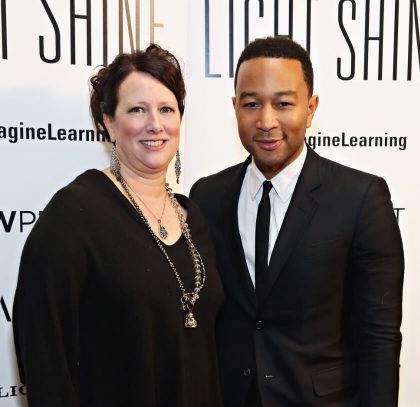
In 2012, Kirsch and her team at New Profit began to reflect on how we could help deepen the focus on underserved students in the K-12 education reform movement to ensure that it is a tide that truly lifts all. Through a field analysis and conversations with education leaders, we could see that the field of organizations focused on supporting students with learning differences (LD) was underscale and lacked entrepreneurial energy. Meanwhile, there was a growing movement focused on advancing social emotional learning (SEL) in direct reaction to the pendulum swinging far from looking at the whole-child as a result of the accountability movement in the 2000s. As SEL became mainstream, we could see an opportunity to explore the intersection of SEL and LD, which operated in separate general education and special education silos, respectively. Education practitioners we spoke with also saw the opportunity. In classrooms, teachers could see students struggling, but were unsure if their challenges were a result of learning and attention issues, social emotional issues, the effects of trauma, or some combination of all these factors. Practitioners also knew that students with LD could benefit from SEL to help them express themselves, gain confidence, work through challenges, and advocate for their needs. And finally, there was a recognition that SEL efforts should be designed around the most underserved student populations to ensure that the movement meets the needs of all learners.
In 2013, New Profit launched a $38M, six-year fund designed to go beyond New Profit’s core work of scaling high-potential nonprofit organizations to address the broader systems-level conditions that were perpetuating educational inequities for underserved students.
We brought together a core group of 30 educators, nonprofit leaders, funders, and strategic partners to define, pilot, and scale collective work focused on creating teaching and learning environments that unleash creativity and potential in all students. We first set a vision: one day, all students—including those with more complex needs and challenges who lack the resources and supports to address them—will be in learning environments that meet their diverse needs and nurture their diverse strengths so that they could achieve both academic and life success. We then defined a set of core beliefs that united this group of leaders coming from siloed corners of the education reform field:
Members of the Reimagine Learning network engage in dialogue on how to craft values-based messaging that will increase the effectiveness of policy advocacy efforts.
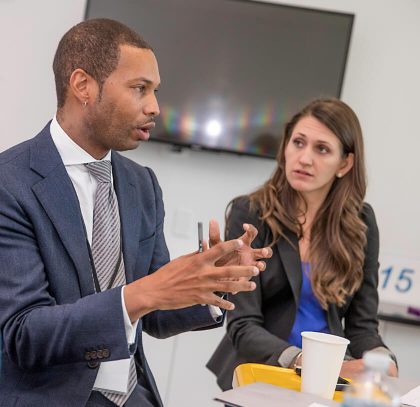
With this vision and core values as guideposts, the group set out to pilot work in three areas:
- PracticeFund and advise organizations focused on serving students with LD to build their capacity while also supporting general education organizations in adopting best practices related to students with LD, with a goal of reaching one million students.
- Policy
Integrate our collective insights and perspectives on optimal learning environments into federal and state K-12 (kindergarten to 12th grade) education policy reform efforts. - Culture
Influence the dialogue in America about how learning happens and the promise and potential of all students—particularly students with LD and those who have experienced large doses of trauma—when they are in optimal learning environments.
Rather than mapping out specific details of the strategic plan, we had a set of general outcomes we were aiming for in each area and focused on working together to build and continuously iterate a strategy with a shared resolve to fundamentally change the education system to better serve all learners.
Reimagine Learning supported the codification of the Lawrence Acceleration Academies, an intervention that contributed to extraordinary gains for students in Lawrence—the first school district in Massachusetts to go into state receivership.
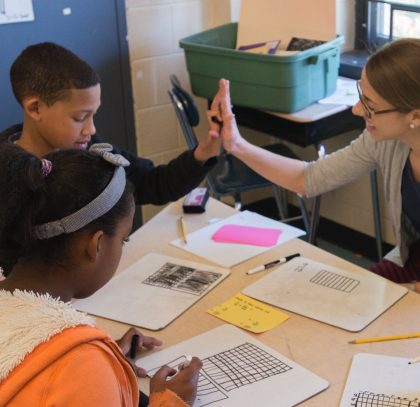
As we launched and piloted this work over the first several years of the fund, New Profit and our growing community of practitioners and funders embraced the adaptive strategy approach. Guided by our vision and core beliefs, we experimented and refined our strategy in response to key learnings, emerging opportunities, and new voices in our community. One key area of evolution was in our definition of our target student population that we aimed to serve.
In 2013, several members of the Reimagine Learning community—Chris Gabrieli of Transforming Education; Don Deshler of the Center for Research on Learning at the University of Kansas; and Mary Dean Barringer of the Council of Chief State School Officers—created a working definition of our target population, which they named “complex learners.” They affirmed that complex learners have a profile that evidences vulnerabilities in one or more of the factors that contribute to learning: opportunity for learning, disposition for learning, neurodevelopmental integrity for learning, and preferences for learning. This definition guided our focus at the outset, but we soon broadened the definition of “complex learners” based on several learnings.
A member of YouthBuild USA’s Young Leaders Council facilitated a conversation at a network convening about how youth, especially those with nontraditional education experiences, should be at the center of the education reform movement.
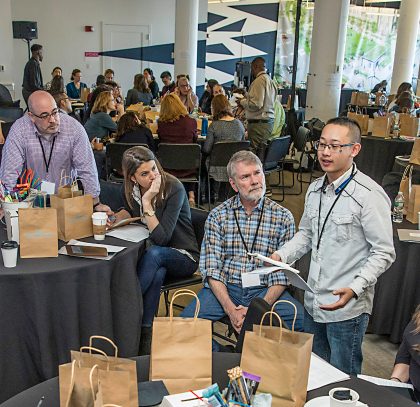
First, we learned that practitioners were struggling to integrate SEL in classrooms because many students have experienced a significant level of exposure to trauma and adversity. Trauma can deeply impact students’ learning, their behavior, and their relationships at school and home. We determined that any work we took on should be trauma-informed, and that we should support the development of learning environments that are trauma-sensitive and make students feel safe.
Second, our community experienced an “ah ha” moment when the 2015 Building a Grad Nation Report was released, which stated that the U.S. can get to a historic high school graduation rate of 90% if we graduate 310,000 more students each year. While this number seemed achievable on its face, once we explored which 310,000 students we would need to get on the path to graduation, we saw that they disproportionately represent the students who historically have been the most underserved by our education system:
Annual Reimagine Learning convenings were an opportunity to bring together members of the network to share insights and spark collaborations.
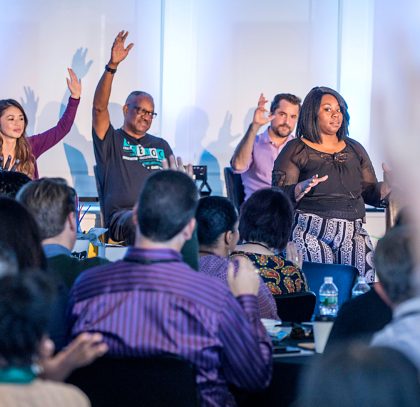
With this data in hand, our group began to expand our focus of underserved students to include students from low-income families, students with undiagnosed and diagnosed LD, students of color, English Language Learners (ELLs), and students who have significant exposure to trauma and adversity.
As our focus broadened over the first several years of the fund, we worked to intentionally build a more diverse Reimagine Learning network that included education leaders who were focused on serving students of color, ELLs, students exposed to trauma, etc. Building on a core group of 100+ people engaged in our work as grantee-partners, funders, and strategic partners, we engaged a broader cross-sector network through convenings, communications, and virtual collaboration. The energy of the network begat greater energy, and soon we had a dynamic and active network of 700+ education leaders across the country excited to cross-pollinate ideas and align actions.
With expansion and diversification, our network began to represent a microcosm of the broader education system. We saw this as an opportunity to begin to break down silos that existed within the education system—first within our network, and then more broadly. To realize our vision of supporting all learners, we need to ensure innovations in general education (such as personalized learning and project-based learning) are optimized to support the needs of the students most underserved by our current education system and ensure that innovations in special education are bridged into general education so that they can benefit all students.

Reimagine Learning exists to support schools and communities to create learning environments that unleash individual potential and creativity in all learners so that they can achieve both academic and life success.
To realize our vision of supporting all learners, we believe it is critical to build specific understanding of and supports for those students whose needs are systematically unmet by the current system.
- Personalized
- Competency-based
- Student-driven
- Multi-model
- Relevant/Contextualized
- Project/Passion-based
- Whole-child
- Students fromlow-income families
- Students of color
- English language learners
- Students diagnosed withundiagnosed learning
differences
- Students who have hadsignificant exposure to
adversity that has
impacted their learning
Not only do general education and special education operate in the same system, the lived realities of students with learning disabilities show that they are often being served in both general education and special education learning environments. To ensure that innovations are being created for ALL students, it is critical that general education and special education reform efforts are synchronized and that all learning environments are designed to effectively serve the most underserved students. This notion guided much of our efforts over the latter years of Reimagine Learning as we sought to fund, support, and strategically align organizations scaling innovations within and across both parts of the education system.
During the final years of Reimagine Learning, we evolved our strategic approach to focus on four areas of impact where we saw the most opportunity to add value to the field.
Grantee-partners engaged in an exercise led by Vantage Partners at a Practitioners Working Group on building capacity for high impact partnerships.
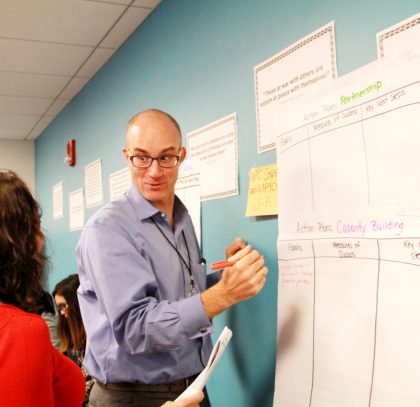
FUNDING AND CAPACITY BUILDING
We invested in 25 high-potential organizations led by visionary social entrepreneurs to help them scale their innovations and enhance their organizational capacity and sustainability, with an eye toward helping them better address the needs of underserved students. In addition to $15M in unrestricted grants, we provided strategic advisory support and $9M in pro bono services from Monitor Institute by Deloitte and Vantage Partners. Collectively serving over 7 million students nationwide, our grantee-partners included organizations building innovations to support underserved students (such as Eye to Eye and Branching Minds) and general education organizations that were deepening their supports for underserved students (such as City Year and Teach For America).
In 2017, we convened grantee partners in D.C. to build their policy advocacy skills and go to Capitol Hill to defend federal funding priorities relevant to Reimagine Learning’s policy platform.
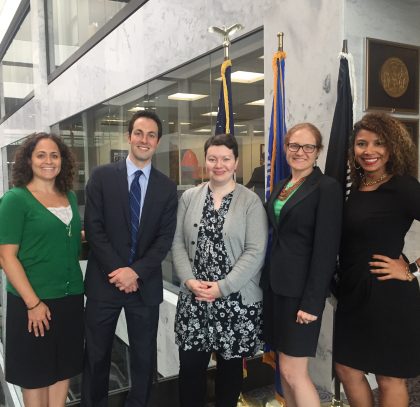
POLICY AND ADVOCACY
Through our nonpartisan policy arm, America Forward, we drove powerful, practitioner-led federal and state policy advocacy to advance public policies that support the success of the most underserved students. Comprised of 40+ education organizations united by a shared commitment to diverse learners, the Reimagine Learning Policy Work Group established a set of policy priorities to support. In 2016, the group successfully advocated for key provisions in the Every Student Succeeds Act (ESSA) that reflected Reimagine Learning’s emphasis on personalized learning, equity, and access. Recognizing both the critical role of state education agencies and the general trend in education policy away from federal control and toward state autonomy as a result of ESSA, the policy work group also explored opportunities to work closely with state leaders. In 2016, we launched an 18-month partnership with the Council of Chief State School Officers’ Innovation Lab Network to advance personalized learning with equity in six states, and created a research review for state education agencies interested in adopting and refining policies and practices to ensure access to personalized learning for students who have been historically underserved.
Network members experienced the power of play during a live learning activity facilitated by Playworks New England at the 2017 Reimagine Learning convening.
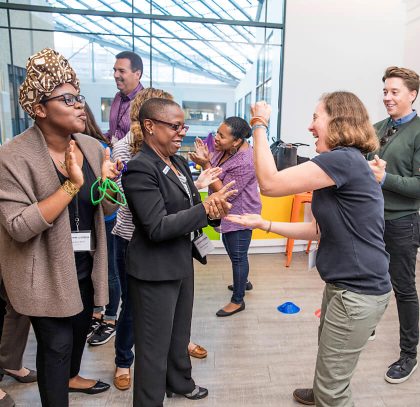
NETWORK ENGAGEMENT
Recognizing the need to create the space for connection and collaboration in the field, we formed a cross-sector network of education leaders to share insights, generate ideas, and identify opportunities for partnership. Consisting of over 700 social entrepreneurs, funders, policy-influencers, practitioners, students, and thought leaders, our network represented over 200 organizations leading breakthrough change in the K-12 education field. We gathered members of the network at 13 cross-sector convenings and engaged the network digitally through a virtual learning series, guest blog series, network digests, and more. The collaboration opportunities that the network afforded led to tangible outcomes: over 300 formal partnerships were launched between network organizations and $30M in additional funding directed to network organizations was generated through relationships created within the network. Within the network, we sought to position youth as leaders in shaping the conversation through initiatives such as Awakening the Mind, which engaged 17 young leaders from YouthBuild USA to create a shared vision for the future of learning that they presented to the full network.
As a part of the Salem Public Schools strategic planning process, we held three Citywide Conversations where community members provided input on the district’s strategy.
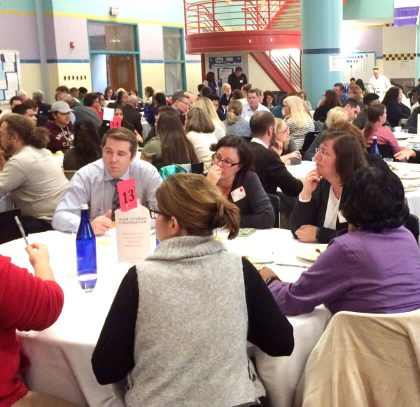
REGIONAL INITIATIVES
We completed three projects in Essex County, MA to develop proof points of districts and schools that are fundamentally transforming to better support all students, particularly the most underserved. In 2016-17, we partnered with the Superintendent of Salem Public Schools to facilitate a community-driven strategic planning process to create a community developed and owned vision of the future of education in Salem, and codified the process in An Educator’s Guide to Community-Engaged Strategic Planning. We also partnered with the Superintendent of Lawrence Public Schools to codify a high-impact intervention, the Acceleration Academies, through a multimedia case study to help share the innovative program with other school districts. In 2018, we launched the Essex County Learning Community to bring together teams from six school districts to engage in collaborative research, inquiry, and professional development focused on improving policies, programs, and practices to effectively serve students with diverse learning assets and needs.
At the Lawrence Acceleration Academies, students have the opportunity to take ownership of their own learning, while also developing deep, personal connections with each other.
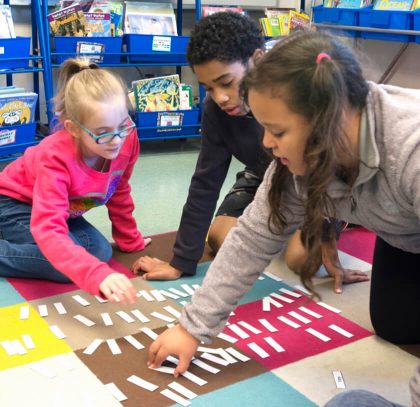
Much has changed in the education ecosystem since the launch of Reimagine Learning: personalized learning has taken off; SEL has gone from nice-to-have to need-to-have; trauma-informed practices are increasingly understood and valued; and it is becoming more common to include students with learning differences in conversations about inequities in our education system. Moreover, we see education leaders starting to look at these efforts in a holistic way and think about how to implement an integrated approach to whole child development that weaves together SEL, academic, and cognitive development with important factors such as mental and physical health and identity.
One of the most important lessons we learned through Reimagine Learning was the importance of breaking down silos and collaborating toward the collective goal of providing a high-quality education to all students. Reimagine Learning was successful in sharing knowledge, aligning actions, and sparking collaborations between leading education organizations across the country. But as we look forward, New Profit is broadening our goal to focus on supporting collaboration and integration at multiple layers of the education ecosystem:
At a 2017 convening, young leaders from YouthBuild USA who participated in Reimagine Learning’s “Awakening the Mind” initiative presented their shared vision for the future of school with members of the network.
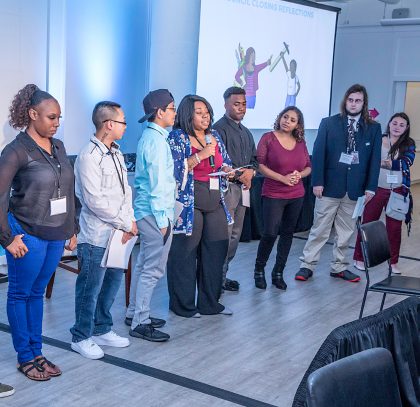
- Across the education continuum—spanning from early childhood to K-12 to post-secondary—to create a seamless pathway for students that prepares them to succeed at each stage of their educational and career journey and engage in lifelong learning.
- Across different focus areas within education—such as personalized learning, SEL, and learner agency—to promote whole child development; and
- Across efforts to create high-quality learning experiences—both in-school and out-of-school—and efforts to empower and activate the students, families, teachers, and communities that will benefit from them to ensure that they are designed by and with these stakeholders.
If successful, this vision would manifest as schools (from preschools to universities), districts, out-of-school programs, etc. partnering with families, young people, and communities to create learning environments and education pathways that meet the individual and holistic needs of all students to ensure they can achieve academic, career, and life success.